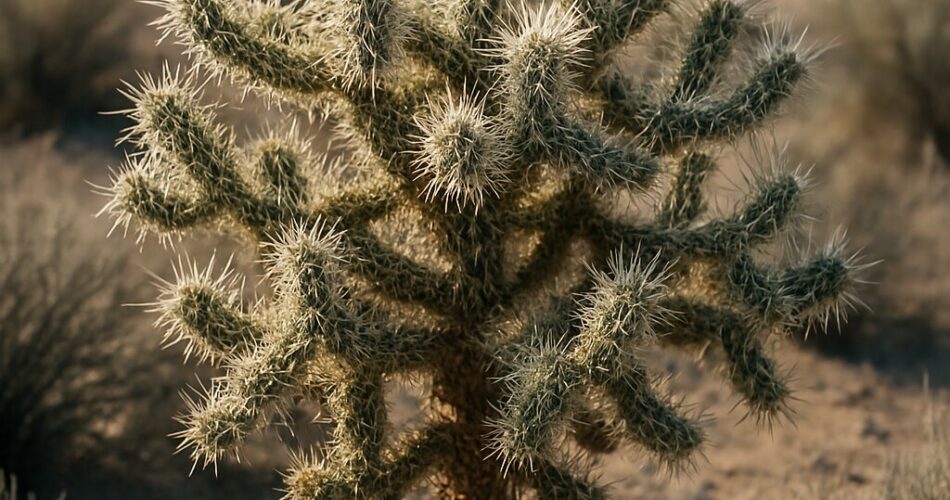Cylindropuntia echinocarpa, commonly known as the Silver Cholla or Golden Cholla, is a fascinating cactus species native to the deserts of the southwestern United States. With its striking silvery spines and vibrant yellow flowers, this plant is not only a marvel of desert adaptation but also an essential component of its ecosystem. In this comprehensive guide, we’ll explore everything you need to know about Cylindropuntia echinocarpa, from its physical characteristics to its ecological importance and care tips.
What is Cylindropuntia Echinocarpa?
Cylindropuntia echinocarpa belongs to the Cactaceae family and is part of the Cylindropuntia genus, which includes other well-known Cholla species. This cactus is characterized by its cylindrical stems, dense spines, and ability to thrive in harsh desert environments.
Scientific Classification of Cylindropuntia Echinocarpa
- Family: Cactaceae
- Genus: Cylindropuntia
- Species: C. echinocarpa
- Common Names: Silver Cholla, Golden Cholla
The Cactaceae family is one of the most diverse plant families, with over 1,750 species. Cylindropuntia echinocarpa is part of the Opuntioideae subfamily, which includes other Cholla and Prickly Pear cacti. If you’re interested in learning more about the Cactaceae family, check out our detailed guide on Cactus Family Classification.
Common Names and Regional Variations
The Silver Cholla is known by different names depending on the region. In some areas, it’s called the Golden Cholla due to the yellowish hue of its spines. These regional variations highlight the plant’s adaptability and widespread presence in desert ecosystems.
The name “Cholla” comes from the Spanish word “choya,” which means “thorny.” This name is fitting, as the plant is covered in sharp spines that deter herbivores and protect it from the harsh desert environment.

Physical Characteristics of Cylindropuntia Echinocarpa
The Silver Cholla is easily recognizable by its unique appearance. Here’s a closer look at its physical traits:
Stem Structure and Spines of Silver Cholla
The stems of Cylindropuntia echinocarpa are cylindrical and segmented, typical of Cholla cacti. These stems are covered in dense, silvery-white spines that can grow up to 2 inches long. The spines serve as a defense mechanism against herbivores and help reduce water loss by providing shade.
The stems are also photosynthetic, meaning they can produce food for the plant through photosynthesis. This adaptation is crucial for survival in the desert, where leaves would lose too much water.
For more information on cactus spines and their functions, visit our page on Cactus Adaptations.
Flowers and Fruits of Cylindropuntia Echinocarpa
During the spring, the Silver Cholla produces vibrant yellow or greenish flowers. These flowers are followed by small, fleshy fruits that are often eaten by desert wildlife. The blooming period is a spectacular sight, adding a splash of color to the arid landscape.
The flowers of Cylindropuntia echinocarpa are pollinated by bees and other insects, making them an essential part of the desert ecosystem. According to the United States Forest Service, the fruits of the Silver Cholla are an important food source for birds and small mammals.
The fruits are also edible for humans, though they require careful handling due to the spines. Native American tribes have traditionally used the fruits in various culinary preparations.
Growth Habits and Size
Cylindropuntia echinocarpa typically grows as a shrub-like cactus, reaching heights of 3 to 5 feet. The plant spreads through both seeds and vegetative reproduction, where detached stem segments take root and grow into new plants.
This method of reproduction is highly effective in the desert, where water and nutrients are scarce. The ability to reproduce vegetatively allows the Silver Cholla to colonize new areas quickly.

Habitat and Distribution of Cylindropuntia Echinocarpa
Cylindropuntia echinocarpa is primarily found in the Mojave and Sonoran Deserts, spanning states like Arizona, California, and Nevada. Let’s explore its habitat in detail.
Ideal Climate for Cylindropuntia Echinocarpa
This cactus thrives in arid climates with minimal rainfall and high temperatures. It prefers well-drained soils and can tolerate extreme temperature fluctuations, making it a true desert survivor.
The Silver Cholla is well-adapted to environments where rainfall is scarce, often receiving less than 10 inches of rain per year. Its ability to store water in its stems allows it to survive prolonged droughts.
For more information on how desert plants adapt to extreme climates, check out our guide on Desert Cactus Adaptations.
Geographic Range of the Silver Cholla
The Silver Cholla is commonly found at elevations ranging from 1,000 to 5,000 feet. Its ability to grow in rocky, sandy, and gravelly soils makes it a versatile species in desert ecosystems.
In Arizona, it is often seen in the Sonoran Desert, while in California, it thrives in the Mojave Desert. The plant’s distribution extends into parts of Nevada and Utah, where it grows in similar arid conditions.
According to the USDA Plants Database, Cylindropuntia echinocarpa is also found in Baja California, Mexico, showcasing its wide geographic range.
Ecological Importance of Cylindropuntia Echinocarpa
The Silver Cholla plays a vital role in maintaining the balance of desert ecosystems. Here’s how:
Wildlife Supported by Cylindropuntia Echinocarpa
The dense spines of the Silver Cholla provide shelter and protection for small animals like birds and rodents. Its flowers attract pollinators such as bees and butterflies, contributing to the desert’s biodiversity.
Birds like the Cactus Wren often build their nests among the spiny stems of the Silver Cholla, using the spines as a natural defense against predators. Additionally, the fruits of Cylindropuntia echinocarpa are an important food source for desert tortoises and jackrabbits.
For more on how cacti support desert wildlife, visit our page on Cactus and Wildlife Interactions.
Soil Stabilization and Desert Ecology
The extensive root system of Cylindropuntia echinocarpa helps prevent soil erosion, making it an essential plant for maintaining desert landscapes. Its roots anchor the soil, reducing the impact of wind and water erosion.
In addition to soil stabilization, the Silver Cholla contributes to the nutrient cycle of desert ecosystems. When the plant dies, its decomposing stems release nutrients back into the soil, supporting the growth of other plants.

Growing and Caring for Cylindropuntia Echinocarpa
If you’re considering adding the Silver Cholla to your garden, here’s what you need to know:
Soil and Water Requirements for Silver Cholla
This cactus prefers well-drained, sandy soil and requires minimal watering. Overwatering can lead to root rot, so it’s best to let the soil dry out completely between waterings.
A mix of sand, gravel, and potting soil works well for container-grown Silver Cholla. If planting in the ground, ensure the soil is loose and free of clay, which can retain too much moisture.
For more tips on soil preparation, check out our guide on Cactus Soil Mixes.
Sunlight and Temperature Needs
Cylindropuntia echinocarpa thrives in full sunlight and can tolerate extreme heat. It’s also frost-resistant, making it suitable for a variety of climates.
In regions with cold winters, it’s best to plant the Silver Cholla in a location that receives southern or western exposure, ensuring it gets maximum sunlight. If grown in containers, the plant can be moved indoors during freezing temperatures.
Common Pests and Diseases
While the Silver Cholla is relatively hardy, it can be susceptible to fungal infections and pests like scale insects. Regular inspection and proper care can help prevent these issues.
To control pests, use a mixture of water and mild soap to spray the affected areas. For fungal infections, reduce watering and ensure the plant has adequate airflow.
For more detailed pest control tips, visit our page on Cactus Pest Management.
Common Uses and Cultural Significance of Cylindropuntia Echinocarpa
The Silver Cholla has both practical and cultural significance, making it a fascinating plant beyond its ecological role. Let’s explore its uses and importance in human history and modern times.
Traditional Uses by Native American Tribes
Native American tribes have long utilized Cylindropuntia echinocarpa for various purposes. The Tohono O’odham and Pima tribes, for example, used the stems to create tools, needles, and even jewelry. The spines were sometimes used in traditional ceremonies or as tattoo needles.
The fruits of the Silver Cholla, known as “tunas,” were also harvested for food. They were eaten fresh, dried, or boiled into a syrup. According to the National Park Service, these fruits are rich in vitamins and minerals, making them a valuable resource in the harsh desert environment.
For more on the traditional uses of desert plants, check out our guide on Native American Uses of Cacti.
Modern Landscaping with Cylindropuntia Echinocarpa
Today, the Silver Cholla is a popular choice for xeriscaping and drought-tolerant gardens. Its unique appearance and low maintenance requirements make it a favorite among gardeners looking to create sustainable landscapes.
In urban landscaping, Cylindropuntia echinocarpa is often used as a natural barrier due to its dense spines. It’s also a great addition to rock gardens and desert-themed landscapes, where its silvery stems and vibrant flowers add visual interest.
If you’re planning a desert garden, visit our page on Desert Landscaping Ideas for inspiration.
FAQs About Cylindropuntia Echinocarpa
Here are some frequently asked questions about the Silver Cholla, along with detailed answers to help readers better understand this unique cactus.
1. What is the difference between Cylindropuntia echinocarpa and other Cholla species?
Cylindropuntia echinocarpa is distinguished by its silvery-white spines and yellow flowers. Other Cholla species, like Cylindropuntia fulgida (Jumping Cholla) and Cylindropuntia bigelovii (Teddy Bear Cholla), have different spine colors and growth habits.
For a detailed comparison of Cholla species, check out our guide on Types of Cholla Cacti.
2. Is Cylindropuntia echinocarpa dangerous?
While the spines of the Silver Cholla can cause injury if handled carelessly, the plant is not inherently dangerous. It’s important to wear thick gloves and use long-handled tools when working with this cactus.
3. Can I grow Cylindropuntia echinocarpa indoors?
Yes, the Silver Cholla can be grown indoors if provided with ample sunlight and well-drained soil. Place it near a south-facing window or under grow lights to ensure it receives enough light.
For more tips on indoor cactus care, visit our page on Growing Cacti Indoors.
4. How fast does Cylindropuntia echinocarpa grow?
The Silver Cholla is a slow-growing cactus, typically adding 1 to 2 inches of growth per year. Its growth rate depends on factors like sunlight, soil quality, and water availability.
5. What animals eat Cylindropuntia echinocarpa?
The fruits of Cylindropuntia echinocarpa are eaten by desert tortoises, jackrabbits, and birds. The plant’s stems and spines also provide shelter for small animals like kangaroo rats and lizards.
Conclusion
Cylindropuntia echinocarpa, the Silver Cholla, is a remarkable cactus that embodies the resilience and beauty of desert flora. From its striking silvery spines to its vibrant yellow flowers, this plant is a testament to nature’s ability to thrive in the harshest environments.
Whether you’re a botanist, gardener, or nature enthusiast, the Silver Cholla offers a fascinating glimpse into the world of desert plants. Its ecological importance, cultural significance, and adaptability make it a valuable addition to both natural landscapes and home gardens.
If you’re inspired to learn more about desert plants, explore our comprehensive guide on Desert Cactus Species.
Founder of CactusClassification.science, David has dedicated years to studying and documenting the diverse world of cacti. Hailing from Arizona, his passion is rooted in the desert landscapes of his childhood. Through this website, David offers insights into cactus taxonomy and care, bridging the gap between scientific research and everyday enthusiasts.



Comments